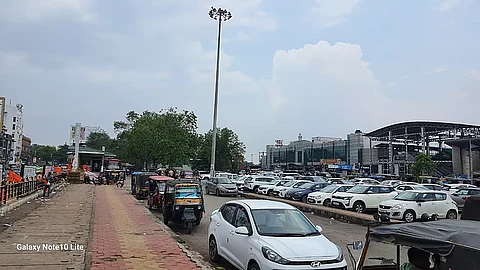

The growing number of vehicles on the roads of Raipur, the capital of Chhattisgarh, is contributing to an increase in road accidents.
According to the Road Accidents in India 2022 report released by the Ministry of Road Transport and Highways, Raipur recorded 1,763 accidents in 2021 and 1,911 in 2022. These resulted in 472 and 583 fatalities, respectively. The number of people injured in these accidents stood at 1,311 in 2021 and 1,322 in 2022.
In 2022, there were 249 pedestrian-related accidents in Raipur, resulting in the deaths of 108 pedestrians. Additionally, 22 cyclists were killed in 63 accidents involving bicycles. Motorcyclists were the most affected, with 401 deaths reported in 1,034 motorcycle-related accidents. Experts suggest that as the number of vehicles continues to rise, so too does the number of road accidents and resulting fatalities.
The report stated that among 50 cities with populations over a million, Raipur ranked 14th in 2021 and 16th in 2022 for road accidents. Between 2018 and 2022, a total of 2,422 people lost their lives in road accidents in Raipur, placing it among the top 10 cities with the highest number of such fatalities. In 2022, Raipur recorded 594 accidents at T-junctions, ranking second after Jabalpur (1,831). These incidents at T-junctions alone claimed 238 lives in Raipur.
Raipur’s rising pollution levels are significantly influenced by the increasing number of local vehicles as well as those passing through from other states via national highways.
Dr Priya Dahake, Chief Medical Officer at Dr Bhimrao Ambedkar Memorial Hospital, told Down To Earth (DTE) that pollutants such as carbon monoxide from vehicles make a major contribution to the city's pollution levels. She noted a marked increase in asthma-related complaints as a result of this pollution.
Echoing her remarks, Dr R.K. Pandey, head of the respiratory diseases department at the same hospital, stated that the issue is not limited to urban areas. He emphasised that even rural regions are reporting an increase in respiratory ailments due to vehicle emissions.
Meanwhile, Hemant Sharma, Deputy Medical Superintendent and Registrar at the DKS Postgraduate Institute and Research Centre in Raipur, also believes pollution is contributing to the rise in asthma cases. He pointed out that pollution levels are exacerbated by the issuance of Pollution Under Control (PUC) certificates without proper vehicle testing. He added that pollution is also leading to an increase in heart and kidney-related illnesses.
Additionally, S.K. Diwan, Senior Scientist at the Chhattisgarh Environment Conservation Board (CECB), informed DTE that vehicular dust contributes the most to Raipur’s air pollution — accounting for nearly 30 per cent.
While the city’s air pollution generally remains in the 'moderate' category, the situation deteriorates during the winter months, especially when stubble burning occurs.
Even in the 'moderate' category, the Air Quality Index (AQI) ranges between 101 and 200, which can be particularly discomforting for individuals with respiratory, asthma, or heart conditions. Data from Continuous Air Quality Monitoring Systems (CAAQMS) at the Raipur Collectorate and the National Institute of Technology (NIT) show rising pollution levels for the same period in 2024 and 2025.
For example, between May 12 and May 18, 2025, the AQI was higher on all days except one when compared with the same period in 2024.
Most weekly AQI readings at both NIT and the Collectorate were elevated in 2025, correlating directly with the growing number of vehicles.
A December 2015 report titled Raipur Public Transport Scoping Study, published by Act on Climate (ACT), had already warned of such trends. According to the Chhattisgarh State Action Plan on Climate Change, 107 initiatives were outlined, of which 16 were transport-related — highlighting the priority given to public transport.
The study revealed that over the previous decade, the number of private vehicles in Raipur had increased annually by 13 per cent, largely due to the lack of a sufficient and convenient public transport system.
It further noted that financial allocations for public transport were primarily limited to large-scale rail projects aimed at medium- and long-distance travel. This approach meant that development of basic urban bus services was neglected.
According to the study, the growth in vehicle numbers far outpaced the growth in population. The study had mentioned that if this trend continued until 2021 (which actually did), the demand for travel would double, causing average travel speeds during peak hours to fall below 20 km/h — slower than cycling.
Traffic congestion, numerous signals, and an overwhelming number of vehicles have worsened the situation. The DTE reporter noted that it took 30–35 minutes to cover a distance of just five–six kilometres in the city.
The study also stated that to achieve a 60 per cent mode share for Public Transport (PT) and Non-Motorised Transport in a PT-focused scenario by 2021, Raipur would need a fleet of at least 674 buses.
The benefits of public transport, according to the report, include time savings, improved productivity, increased investment, better health outcomes due to reduced pollution, and lower carbon emissions.
Officials from the Department of Urban Administration and Development noted that Chhattisgarh never formed a Transport Corporation, which is essential for improving public transport. They also highlighted the need for permanent staffing of societies operating city buses, pointing out that this is not just a revenue-generating service, but a basic public need and an environmental imperative.
This article is part of our series on how India moves, which looks at the relationship between air quality and human mobility in cities and towns. This story is the fourth in the Raipur mobility series. Also read the first, second and third parts.